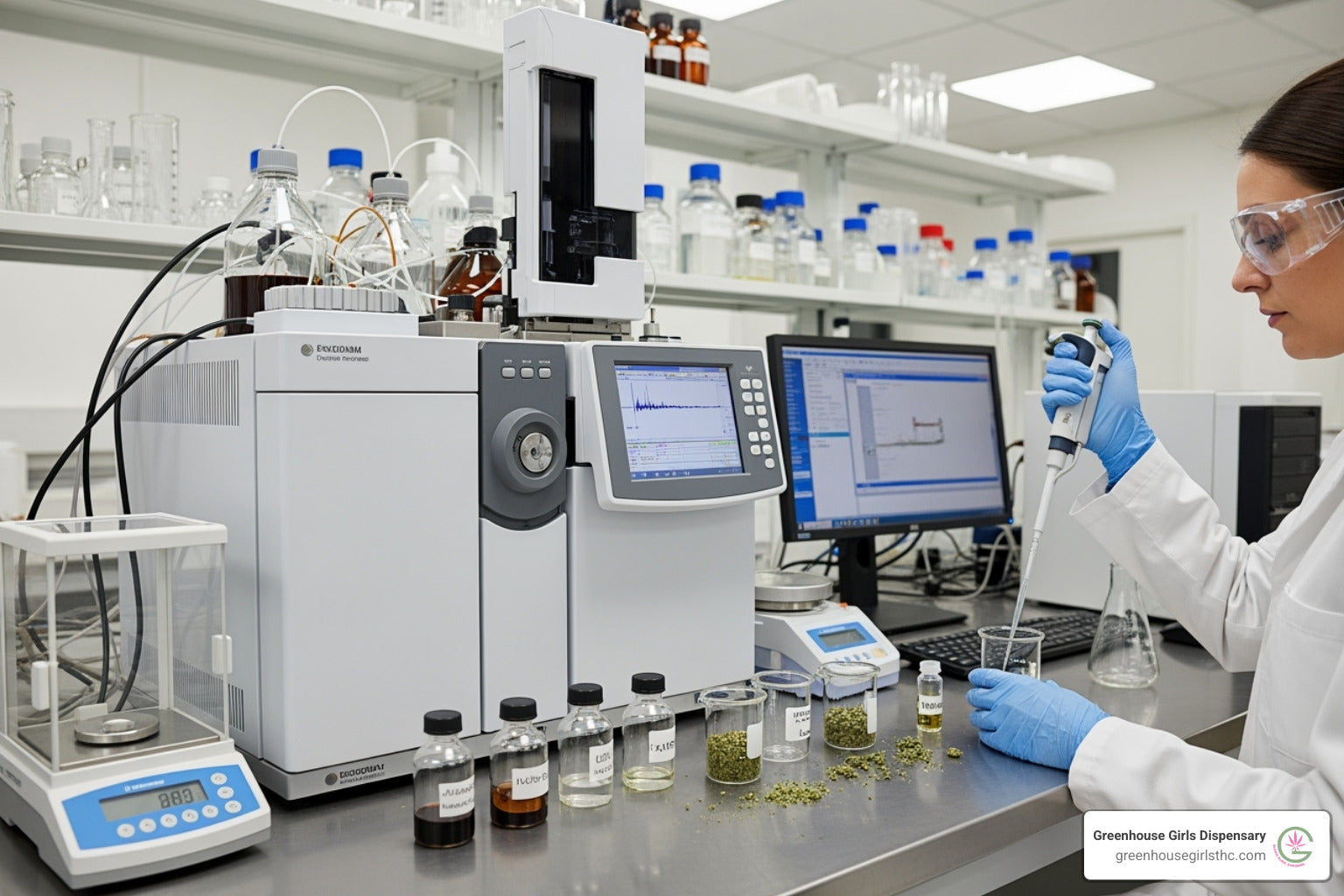
Why Your Weed Needs a Check-Up: The Importance of Cannabis Analysis
Why Cannabis Analysis is Your Best Friend for Safe, Effective Products
Cannabis analysis is the scientific process that reveals exactly what's in your cannabis products. This testing identifies key components like cannabinoids (THC, CBD) and terpenes (aroma compounds), while also screening for harmful contaminants like pesticides, heavy metals, mold, and residual solvents from extraction.
Why does it matter? Analysis ensures product safety, verifies potency claims, confirms legal compliance (especially THC levels), and protects you from harmful substances. You wouldn't buy food without a nutrition label, and the same standard should apply to cannabis. With an estimated 200 million people having used cannabis in 2019, many are consuming products without knowing their true contents.
The stakes are real. Unregulated markets can expose consumers to dangerous pesticides or inaccurate potency levels. As the legal hemp market grows, proper analysis using techniques like HPLC and mass spectrometry is more critical than ever to ensure you get exactly what you pay for.
I'm Selena Jochumsen, and through my work with Greenhouse Girls Dispensary and advocacy with the National Cannabis Industry Association's Hemp Committee, I've seen how rigorous analysis protects consumers and builds trust. Educated consumers make better choices, and that starts with understanding what's in your products.
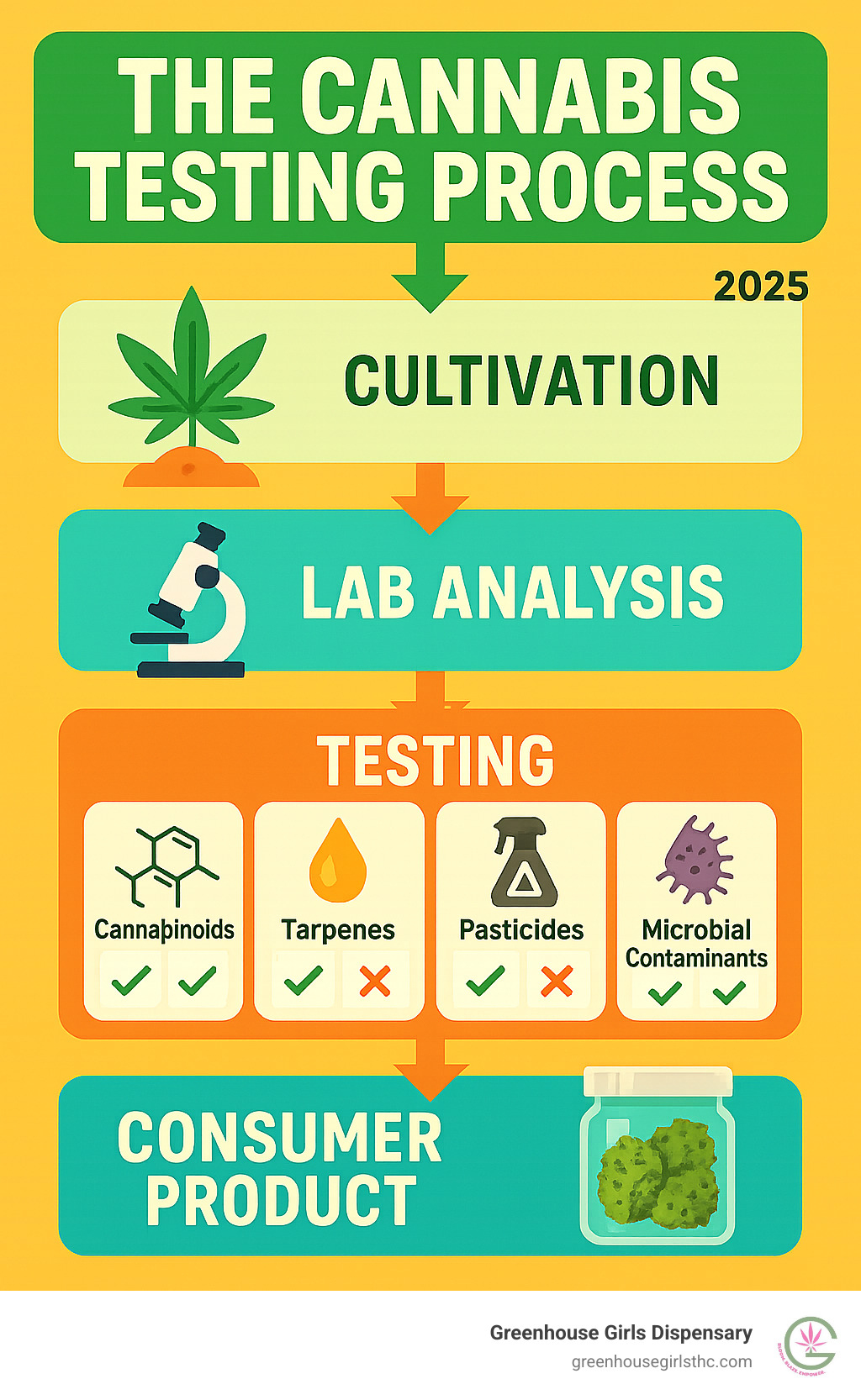
What's in Your Cannabis? Key Analytes Under the Microscope
When you view a Certificate of Analysis (COA), you're looking at a product's chemical fingerprint. Cannabis analysis reveals the complex world of compounds creating your experience. The cannabis plant is incredibly complex, with over 550 different molecules contributing to its unique properties. This complexity is why we take testing so seriously at Greenhouse Girls. For a deeper dive, this comprehensive review on Cannabis sativa explores the full range of compounds.
Potency Profiling: Cannabinoids
The stars of any cannabis analysis are the cannabinoids, which interact with your body's endocannabinoid system. THC (Delta-9-Tetrahydrocannabinol) is the most famous, creating the classic high. Our Delta 9 gummies are crafted for consistent, federally legal THC levels. CBD (Cannabidiol) offers potential therapeutic benefits without psychoactive effects. Learn more about THC vs. CBD differences.
It gets more interesting with acidic precursors. THCA (Tetrahydrocannabinolic Acid) is THC's non-psychoactive parent, found in our THCA flower. It only converts to THC when heated (decarboxylation). CBDA is the precursor to CBD.
Minor cannabinoids like CBG, CBN, and THCV add their own unique properties. Delta-8 THC has become popular for its milder effects compared to Delta-9. Our analysis of Delta-8 vs. Delta-9 THC breaks this down. Labs calculate Total THC using a formula that accounts for the potential conversion of THCA, giving you the true potency. All these compounds work together in what's known as the entourage effect, enhancing each other's benefits.
The Aroma and Flavor Engine: Terpenes
Terpenes are the aromatic compounds that give each strain its unique smell, flavor, and character. They also contribute to the effects. Myrcene has an earthy aroma often linked to relaxation. Limonene is citrusy and considered uplifting. Linalool has a floral scent associated with calming effects. Caryophyllene is unique because it can interact directly with cannabinoid receptors, offering spicy notes and potential anti-inflammatory benefits. Terpene profiling helps us understand how a product might make you feel.
Screening for Unwanted Guests: Contaminants
This is a crucial part of cannabis analysis: ensuring products are free from harmful substances. Cannabis plants can absorb contaminants from their environment, so we test for everything. This includes pesticides from cultivation, heavy metals (lead, arsenic) from the soil, and microbial contaminants like mold, E. coli, and salmonella. We also screen for mycotoxins (toxic compounds from mold) and residual solvents left over from extraction processes. This is why we only work with third-party labs and source from clean-growing family farms, ensuring every product is pure and safe.
The Science of Safety: A Deep Dive into Cannabis Analysis Methods
Ever wondered how labs identify compounds in your cannabis down to the parts per million? Behind every Certificate of Analysis (COA) is a suite of sophisticated analytical chemistry techniques that make this precision possible, ensuring both product quality and consumer safety.
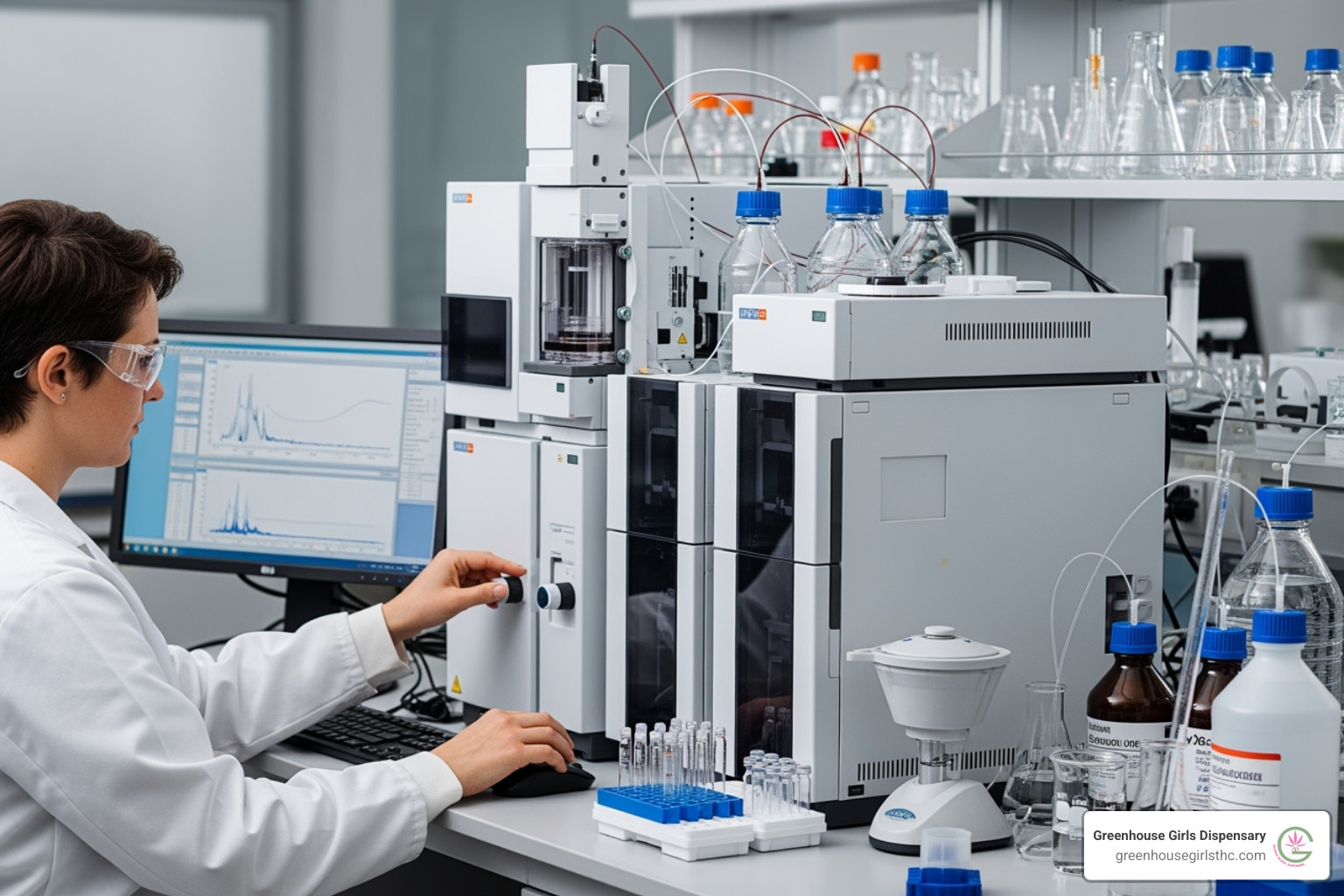
The Gold Standard for Potency: High-Performance Liquid Chromatography (HPLC)
For measuring cannabinoids accurately, High-Performance Liquid Chromatography (HPLC) is the gold standard in cannabis analysis. Crucially, HPLC is a "no-heat" method. This is vital because heat converts acidic cannabinoids like THCA and CBDA into their active forms (THC and CBD). Using a method with heat would give false results, potentially misclassifying a legal hemp product. HPLC's gentle approach shows us exactly what's in the plant, allowing for precise quantification and accurate potency labeling on products like our THCa flower.
Advanced Detection: Mass Spectrometry (LC-MS & GC-MS)
For detecting trace contaminants and identifying specific terpenes, labs use mass spectrometry. These machines are like molecular detectives, identifying compounds with incredible precision.
- LC-MS (Liquid Chromatography-Mass Spectrometry) is ideal for detecting pesticides and mycotoxins at extremely low levels.
- GC-MS (Gas Chromatography-Mass Spectrometry) excels at terpene profiling and testing for residual solvents. It's also sensitive enough to handle isomer differentiation, which is critical for telling apart nearly identical molecules like Delta-8 THC and Delta-9 THC. This is crucial since they have different legal statuses and effects.
Identifying Different Products with cannabis analysis
Not all cannabis products are tested the same way. Each type presents unique challenges.
- Flower analysis is relatively straightforward, focusing on cannabinoids, terpenes, and screening for contaminants on the raw plant.
- Oil and concentrate testing requires extra steps to ensure no residual solvents from the extraction process remain.
- Edible analysis is the trickiest. Ingredients like sugars and fats in our Delta 9 gummies can interfere with analytical instruments, a phenomenon known as "matrix effects." Labs must use specialized, validated methods to overcome this interference and ensure the cannabinoid measurements are accurate. This advanced science ensures that whether you prefer flower, gummies, or vapes, your product has been tested with methods designed specifically for it.
Ensuring Accuracy and Trust: Quality Control in Cannabis Testing
The best analytical methods are only as good as the lab performing them. We take immense pride in our commitment to transparency, which includes sharing our lab results (COAs) with you. This dedication to quality is what sets us apart.
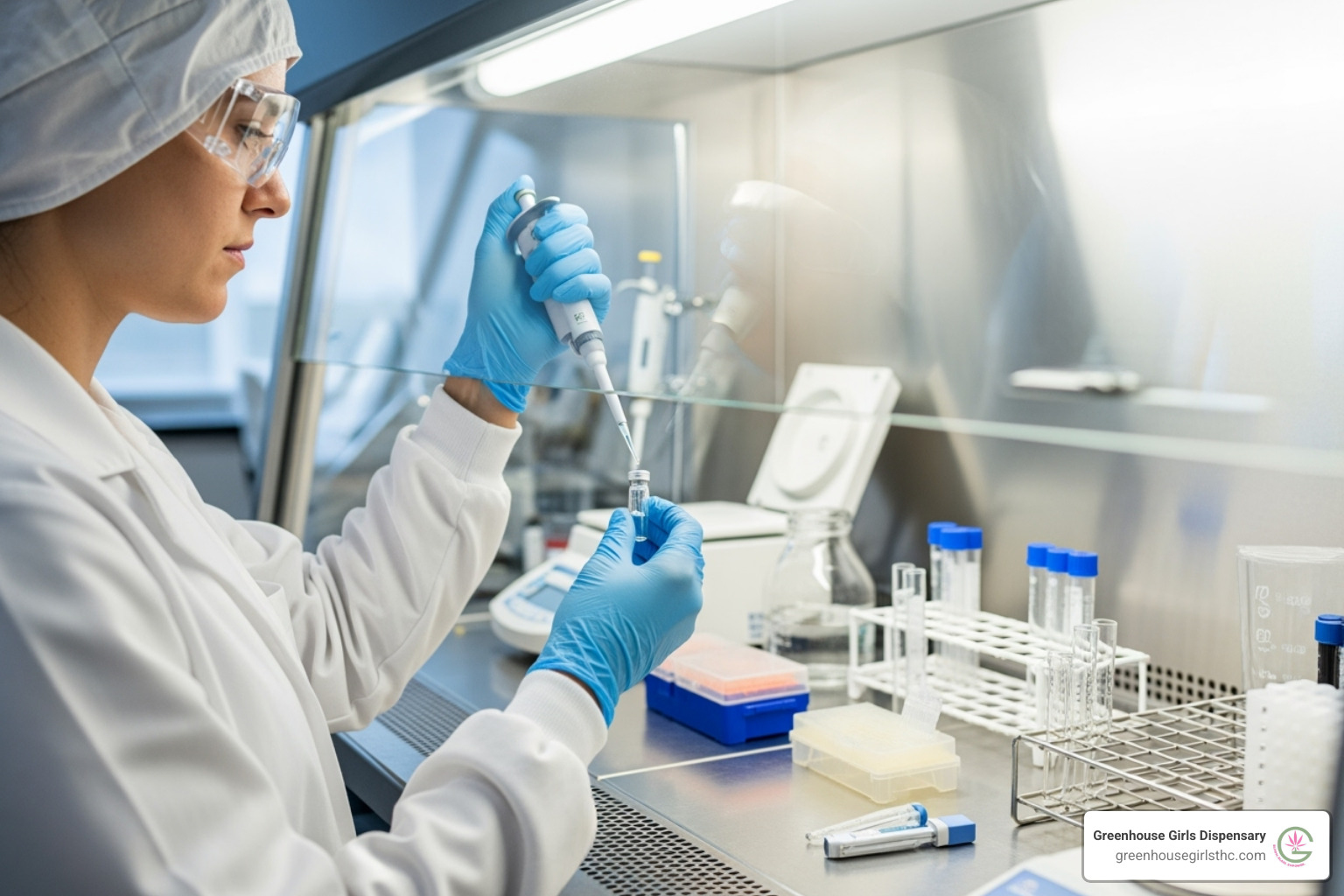
Starting with the Source: Proper Sampling
Before any analysis, the sample must be representative of the entire batch. This involves taking samples from different parts of a batch and homogenizing (grinding) them into a uniform powder. This ensures the small portion tested accurately reflects the whole. A strict chain of custody is also maintained from farm to lab to prevent tampering or mix-ups.
The Lab's Playbook: Method Validation and Quality Control
Once a sample arrives, it enters a highly controlled environment. Our labs adhere to the highest standards to ensure accuracy.
- ISO/IEC 17025 Accreditation: This international standard is a non-negotiable for us. It signifies that a lab's methods are validated, its staff is competent, and its results are reliable.
- Proficiency Testing (PT): Labs regularly analyze unknown samples from programs like the AOAC's Cannabis Analytical Science Program (CASP) to verify their accuracy against other accredited labs. You can even join a working group to help develop standards.
- Key Metrics: Labs must demonstrate high accuracy (closeness to the true value) and precision (consistency of results). They also establish a Limit of Detection (LOD) and Limit of Quantification (LOQ) to detect even trace amounts of contaminants.
These measures ensure that when you see "lab-tested" on our products, you're looking at results you can trust. The COA for our Delta 9 gummies, for example, verifies they are federally legal, which is key to understanding Why Hemp Gummies Get You High (And Why That's Legal).
The Unsung Heroes: Reference Standards and Consumables
Accurate cannabis analysis relies on high-quality lab materials. Certified Reference Materials (CRMs) are purified substances used to calibrate instruments, acting as a "gold standard" for measurements. High-purity solvents and specialized chromatography columns are also essential. These foundational tools ensure every analysis yields reliable and trustworthy results.
Navigating the Rules: Regulations and Challenges
The legal landscape for cannabis is a complex puzzle. As someone involved with the National Cannabis Industry Association's Hemp Committee, I've seen how this regulatory environment impacts every aspect of cannabis analysis. At Greenhouse Girls, we steer this framework to ensure our products are legal in Florida and for nationwide shipping.
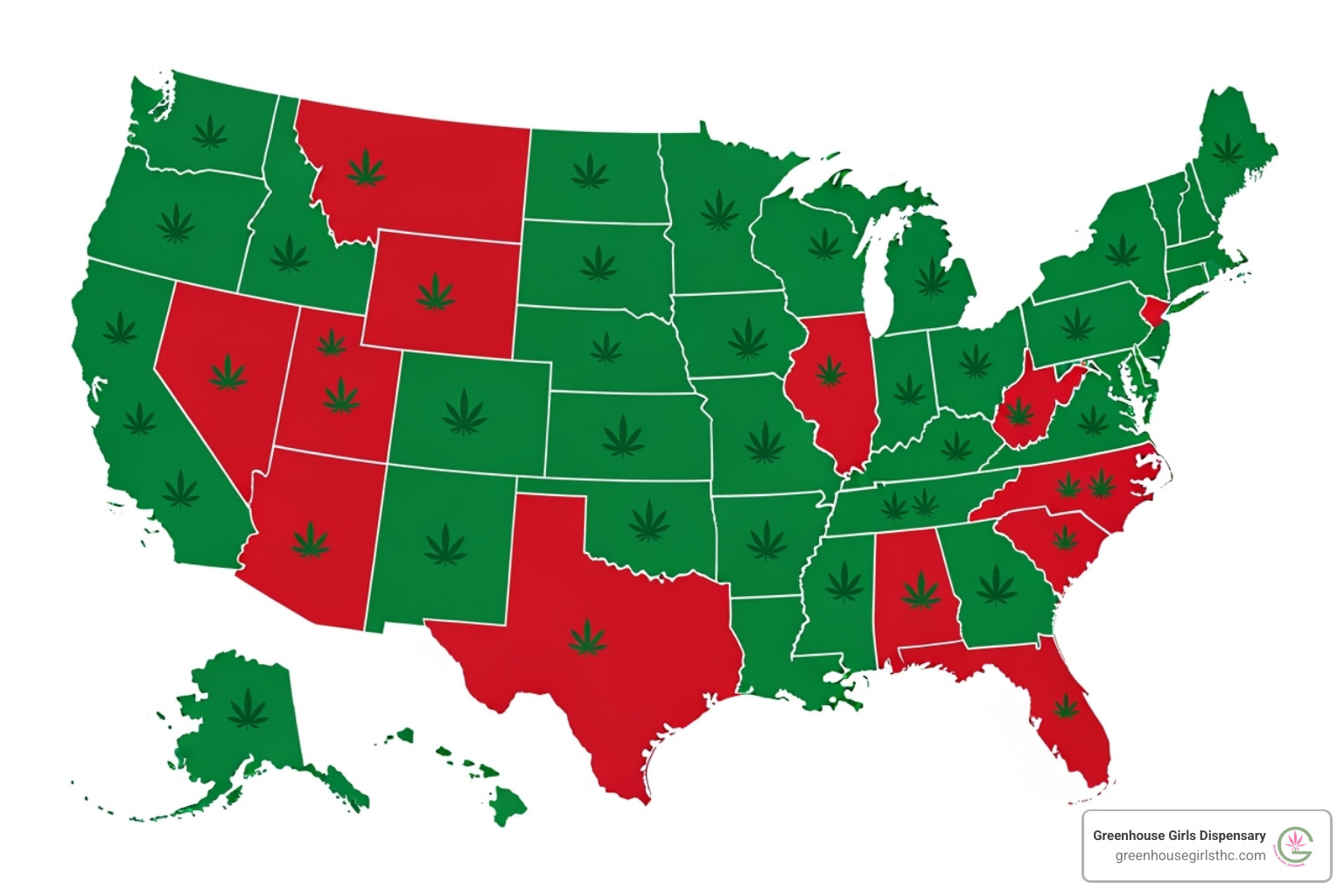
The Patchwork of a Nation: Regulatory Requirements
The U.S. cannabis industry is governed by a mix of state and federal laws. While cannabis remains federally illegal, the Federal Farm Bill of 2018 legalized hemp and its derivatives.
- The 0.3% THC Rule: This is the dividing line between legal hemp and illegal marijuana. Any product with more than 0.3% Delta-9 THC by dry weight is considered marijuana. Our products are hemp-derived and tested to stay within this limit. Learn more about Hemp-Derived vs. Marijuana-Derived Cannabis.
- Action Limits for Contaminants: Jurisdictions like Health Canada under its Cannabis Act set strict limits for pesticides, heavy metals, and microbes. Products that fail these tests cannot be sold.
- Labeling Requirements: Laws mandate transparent labeling with potency, ingredients, and test results, empowering you to make informed decisions.
Overcoming Problems in cannabis analysis
Cannabis testing faces unique scientific challenges that labs work to overcome.
- Sample Complexity: Testing flower is different from testing gummies or vapes. Each product "matrix" requires its own preparation methods.
- Matrix Effects in Edibles: Food ingredients in edibles can interfere with testing equipment, making it harder to get accurate cannabinoid readings. Specialized techniques are needed to overcome this.
- Isomer Differentiation: Distinguishing between similar compounds like Delta-8 THC and Delta-9 THC requires advanced methods to ensure you get the product you expect, as their effects and legal status differ.
- Lack of Federal Standardization: Without uniform federal standards, testing methods can vary between states. This inconsistency is a major challenge, underscoring why we commit to working only with ISO/IEC 17025 accredited labs for all our products.
Frequently Asked Questions about Cannabis Analysis
Diving into cannabis analysis can feel overwhelming. After years of helping customers, I've noticed the same questions come up again and again. Let's tackle them.
How do I read a Certificate of Analysis (COA)?
A COA is your product's report card. You can access ours via a QR code on the packaging. Here's what to look for:
- Lab Info: Check for the lab's name and ISO/IEC 17025 accreditation.
- Product Info: Verify the product name and batch number match what you bought.
- Cannabinoid Potency: This shows the levels of THCA, Delta-9 THC, CBD, etc. For our gummies, you'll see the Delta-9 THC is below the 0.3% legal limit, which is why hemp gummies get you high and why that's legal.
- Safety Screening: Look for a "Pass" result for pesticides, heavy metals, mold, and residual solvents. A "Fail" is a major red flag.
- Terpene Profile: This section details the aromatic compounds that influence the product's flavor and effects.
Why do test results for the same strain sometimes vary?
Cannabis is a natural product, so variation is normal. Factors like growing conditions (soil, sunlight), harvest time, and curing methods can all alter a plant's chemical profile. Even the part of the plant tested matters, as buds are more potent than leaves. Minor differences can also exist between accredited labs due to slight variations in equipment or validated methods. This is why we test every single batch to ensure you know exactly what's in the product you're holding.
Is "lab-tested" a guarantee of quality?
"Lab-tested" is a great start, but the quality of the testing is what truly matters. Here's what to demand:
- Third-Party Testing: We only use independent, ISO/IEC 17025-accredited labs. They have no financial stake in the results, ensuring an unbiased assessment.
- Transparency: A reputable company will make its COAs easily accessible. If a brand hides its results, be skeptical.
- Comprehensive Testing: Potency-only testing isn't enough. Our cannabis analysis covers the full spectrum: cannabinoids, terpenes, and a complete safety screening for contaminants.
The bottom line: "Lab-tested" from a transparent company using an accredited third-party lab gives you confidence in both safety and potency. It's how we can confidently offer a free Baby Jay with your first visit.
Conclusion: Why Lab-Tested Cannabis is the Only Choice
After diving into cannabis analysis, one thing is clear: choosing lab-tested products is essential. It's the real-world protection that stands between you and potentially dangerous products. A Certificate of Analysis is proof that your product has been vetted by scientists using sophisticated equipment.
Without proper testing, you risk consuming products with inaccurate potency, harmful pesticides, heavy metals, or even mold. At Greenhouse Girls Dispensary, we've built our business on transparency and safety. Every product we carry—from our flower shake deals and prerolls to our precisely dosed 25mg Delta-9 gummies—undergoes rigorous third-party cannabis analysis at ISO/IEC 17025 accredited labs.
We partner with small family farms who share our values. When you choose our THCa flower or 50mg Delta-8 gummies, you're getting a product tested throughout its entire journey. Whether you visit us in Palm Harbor or Oldsmar, Florida, or use our nationwide shipping, you can trust that every product has passed comprehensive testing.
We believe everyone deserves quality cannabis, which is why we're offering a free preroll or gummy with your first visit. See the difference proper testing makes. Don't settle for anything less than lab-tested. Your health and peace of mind are worth it.
Explore our lab-tested flower selection and find the Greenhouse Girls difference today!


